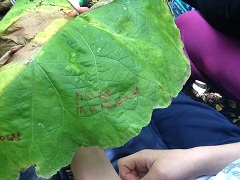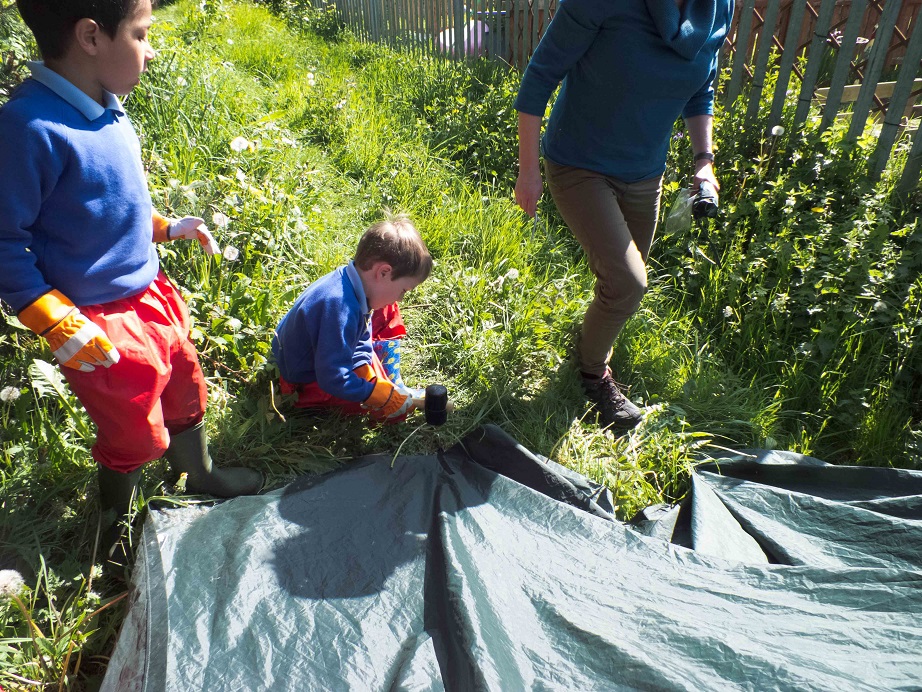- Details
-
Tuesday, 22 May 2018 13:05
-
Harriet Menter
To follow on from my last blog I had some great feedback and discussions. The most useful was from my friend Emma who (quite rightly) questioned the fact that I am asking people to reflect “on demand”. Reflecting on our actions and emotions is a complex process and when you ask children and young people to cease the activities they are enjoying and come over and do something you want them to do, it is unsurprising that the outcome may not offer any deep insights. Recently I have been trying (quite unsuccessfully at times) to facilitate reflection with the group I am discussing below. The main problem being that they are always having such fun and reflection signals an end to that fun! I have found two strategies that are working to some degree. Having informal discussions with people while they are engaged in an activity such as sawing or swinging in a hammock, seems to work well. As does asking school staff to facilitate reflection with the group back in the classroom setting where the alternative is school work which is not as appealing as climbing a tree or playing a game with friends.
Communities of Learning
Recently I have been running a forest school programme for a group of KS4 young people with emotional issues including severe anxiety. The group come once a week for a session at the garden. Within the group there are many different needs, issues and types of behaviour. Some of the group are extremely lacking in confidence, and need a lot of support to even give something a go (like lighting a fire or using a tool). Others can at times be aggressive and violent towards peers and staff. Overall most members of the group seem to enjoy coming into the woods, and are generally actively engaged in their own activities, challenges I set them, or games we play together. A few will only really engage if given one to one support.

Within this group there are 3 young men who seem to enjoy coming to the sessions and seem to really enjoy each other’s company. They will always choose to work together and seem to be constantly giggling and joking with each other. However, they also do this when I am talking – at the beginning of the session letting people know what the options are, or during a break for food and drink, or at the end when I am trying to hear from the young people what they have been up to, what they enjoyed, and what they are planning on doing next week. If the hammocks are available, they will always choose them, and will put them up and swing each other a bit too vigorously for our 20-year-old trees. If hammocks are not available they will often entertain themselves with an activity that challenges me, and challenges our forest school agreement (look after yourself, each other and nature) even more; like hitting apples with a big stick onto a footpath nearby, or hanging a piece of wood off a tree and taking turns to whack it.

The last activity doesn’t actually challenge the forest school agreement, but is indicative of what for me is the nub of the problem. I don’t feel like these young people are benefitting enough from the sessions. They are not really challenging themselves, or learning new skills, that I would hope would help them develop their confidence and self-esteem.
I took this problem to the Forest School Tyne and Wear network group, where we were testing out a procedure developed by Newcastle University to facilitate reflective practice and communities of learning. We agreed ground rules, I presented my problem, and then the rest of the group asked questions and made suggestions for ways forward. As part of the process I promised to write up the suggestions and report back to the group… which is coming up in the next blog. In the mean time I’d value your thoughts…..

- Details
-
Tuesday, 20 June 2017 11:11
-
Harriet Menter
Reflecting on reflection:
Reviewing and reflecting and such an important part of forest schools. I like to think I fully understand the why: helping children and adults to recognise and embed their learning, identify how and why we achieved an outcome (or didn’t), recognize gaps in our skills and knowledge or areas where we could improve in the way we acted and reacted, develop an understanding of our own strengths and weaknesses, helping us grow and develop as human being. And for me as a forest school leader, when children share their reflections it helps me understand what has worked, what hasn’t worked, where the children are at, and what support they might need in the future.
But it’s the how I’ve always struggled with. When I started as a forest school practitioner 7 years ago, I used to ask children to tell me what their favourite bit of the day had been, and explain why. The first problem with this is that they would often repeat what the first child said. The second was that children often struggled to explain why. In one memorable session, I had invited someone to observe me to give me some feedback on my practice, and I asked a reception child, “so Jimmy, what was your favourite thing today?”. He thought for a while and said in a bright voice “my grandad’s got a ladder”.
So I started looking around for more inspiration. I asked some of the Forest School facebook discussion groups. I looked at the mosaic approach which I think would work if I had the children inside in a classroom after the session, as a class teacher might do, and we could look at pictures together, and reflect on what happened. But for me, once the kids leave the garden I don’t see them again until the following week.

I know Roger Greenaway has a lot to offer but many of his approaches involve a lot of talking, and require a certain level of insight to begin with. Great when I’m training adults, but the challenge for me is that the children I work with are often very young (I usually find myself working with ages 4 - 6) and often unable to articulate their thoughts and emotions well, and they get bored listening to others for too long. I have developed and adapted techniques that involve movement, drawing, painting with some success. For example, a rope on the ground and a choice, “if you enjoyed working alone today stand on this side, if you enjoyed working with others stand on that side”. Obviously, they could have enjoyed both, but a good start for a discussion. Or playing an adaptation of the game “corners”. Where different spots, often with a piece of equipment to aid memory, may represent something that happened during the session (recently we had a choice of sawing, climbing trees, swinging in hammocks, stick fighting, climbing the hill, making creatures and hide and seek as options). I migth ask which was the favourite, or which was the hardest, or most interesting. Again children vote with their feet and explain their choice, first to a neighbour and then to the group. As they explain why they have chosen that corner, I can ask further questions to help draw out the learning, make connections, scaffolding the process of reflection. But all that talking take time, makes other kids twitchy, standing around waiting for their "go". I know I don’t need to hear it all, it’s their reflection and their development after all, but I soooo want to hear it all, to understand how I can support their future development.

I was reminded of how challenging the process of reflecting with EYFS is recently when short of time I asked a group of 15 reception children to tell their neighbour their favourite thing about the day, and the tell me. One boy told me that den making had been his favourite thing because it was like the army, and he wanted to be a soldier. So far so good, except that I had been supporting this boy and his friend in putting up their tarp den earlier on (a task I had set due to the weather) and they showed very little interest in it at all! What I had seen them really enjoy was sawing wood cookies to decorate. So, was the reflection flawed? Together with my observation it tells me a lot about this boy and how he sees himself (as someone who likes all things related to the army). But by itself it doesn’t tell me what I need to know. And does it help him recognise his strengths/weaknesses? Well, no. Had I had time I could have gone on to ask whether he thought he had done a good job. Was he proud of his den? Could it have been better? What could he have done to make it better? But with 5 minutes left and 6 other children still wanting to tell me their favourite thing, we couldn’t explore those questions.

These frustrations all came to mind when I was invited to a meeting with a local school who are to be working with a digital civics (IT to help the community) project at Newcastle University. They wanted to explore how technology could support forest schools. I suggested a tool to aid review and reflection, that the children and adults could use. Maybe the children take photos and annotate them with icons representing how they see themselves in those moments, and maybe it’s a shared platform that I can look at once the children have left. I don’t know what it should look like, or what technology that might use, or whether they will even go with my suggestion (there is a great young researcher with his own ideas), but I do know that finding better ways to facilitate refection would be such a useful contribution to my own forest school practice and hopefully many others’.






